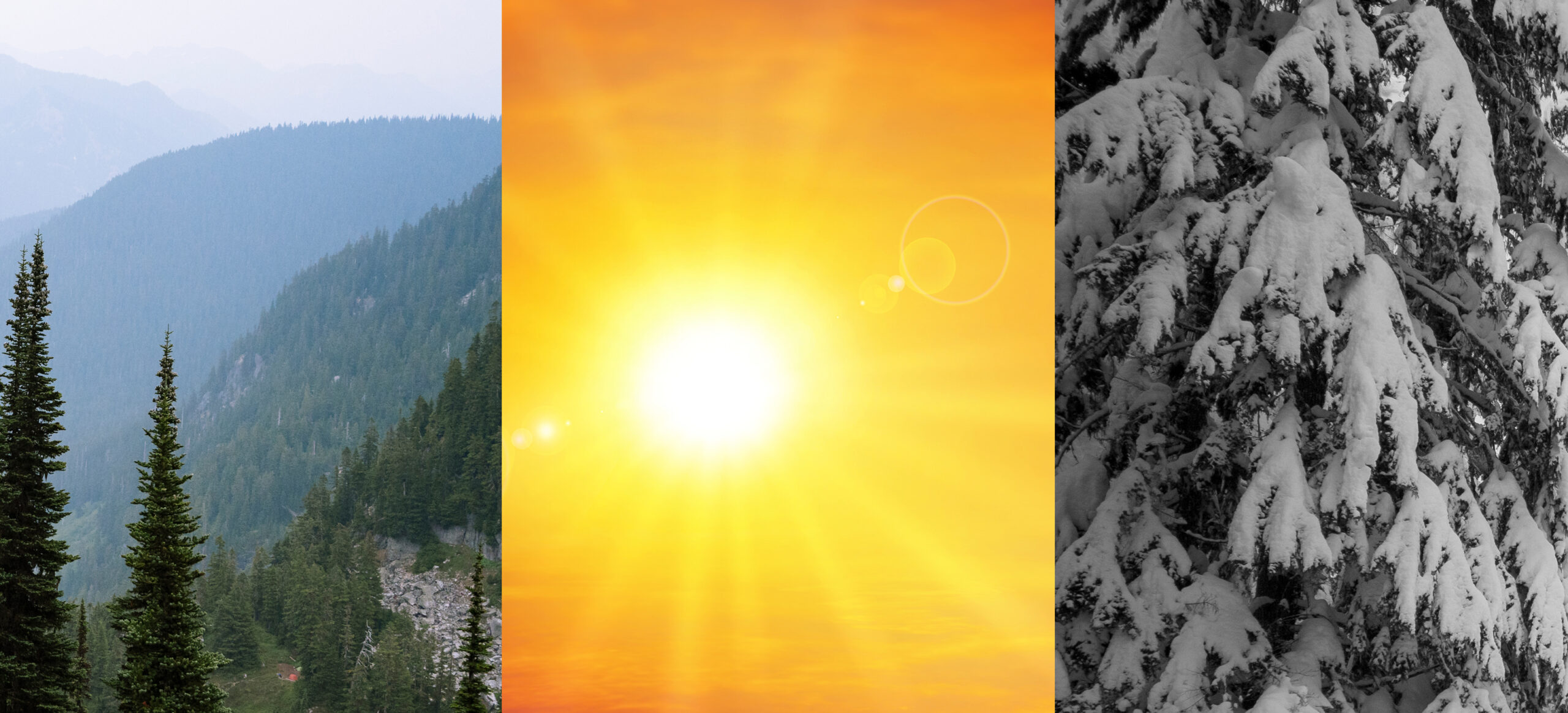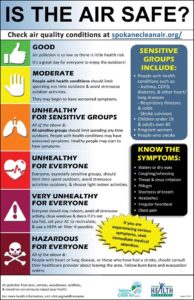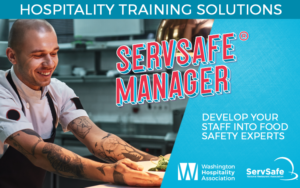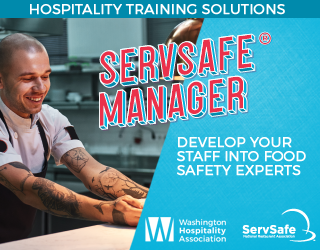
New year-round wildfire smoke worker protections
The Department of Labor and Industries has implemented new, year-round rules to protect workers from wildfire smoke. (This is a change from previous years when temporary rules were adopted only during wildfire season.)
Employers must be prepared for the impact smoke has on their employees who work outside by creating a response plan, providing training to employees, monitoring smoke levels and ensuring employees have access to prompt medical attention.
The table on the next tab outlines what must be done when the air quality reaches certain levels. Be sure to check any of the links below to find air quality levels near you.
WILDFIRE AND EXTREME HEAT SEASON IS HERE: DO YOU KNOW WHEN YOU SHOULD CLOSE YOUR PATIO?
It’s become almost a yearly event. Smoke from nearby wildfires hangs over the area, creating hazardous conditions for anyone working or enjoying the outdoors. Cities across the state often wake up to smoky conditions during the hot summer months, starting earlier in the year. So, how can you know when the air is too unhealthy for workers and your guests?
National Restaurant Association resource: Always ready, natural disasters – wildfires
Check out this resource from the National Restaurant Association to prepare for and react to a wildfire. National also has a resource for when your building has a fire.
SMOKE EXPOSURE
Remember: health officers have the authority to shut down any outdoor event or space with unhealthy air quality.
WHAT YOU NEED TO KNOW
Download the EPA AIRNow app for your iPhone or your Android device. This app will describe air conditions in your area.
Download the following photo, print it out and post it in your office to remind everyone when it is time to close the patio.
In its newsletter, Spokane Regional Clean Air Agency recently included an article from former Spokane Regional Health District Health Officer Bob Lutz explaining the smoky air hazards.
“Smoke from wildfires is a complex mixture of substances that includes water vapor, heavy metals, hydrocarbons, gases such as carbon monoxide and ozone, and particulates.
“While the general effects of smoke often irritate the eyes, nose and throat, the greatest concern is caused by the smallest particles, PM2.5. These can get deep into the lungs, be absorbed into the blood and cause inflammation throughout the body. Their effects can worsen pre-existing conditions, such as asthma, COPD, and heart disease. Additionally, infants and children, adults over age 65 and pregnant women are at increased risk from exposure. And those who cannot get out of the smoke, such as individuals living homeless, are likewise impacted.
“The reality, however, is that everyone is at risk because there is no safe level of PM2.5. Studies have shown increased healthcare visits as well as increased hospitalizations and even deaths, both during and soon after periods of poor air quality from wood smoke.”
Useful websites during wildfire events:
- Spokane Regional Clean Air Agency’s air quality index
- Puget Sound Clean Air Agency: Wildfire smoke
- Other clean air agencies in Washington
- Department of Ecology, State of Washinton’s air quality map of the state
- Department of Ecology: Smoke & fire management
- Washington Smoke Blog
- Department of Labor & Industries “Wildfire smoke and Washington Workers“
- Department of Natural Resources map of current wildfires
It’s important to note that air quality sites don’t report the air quality in real-time but an average of the last 24 hours.
How do you know when to close your patio?
According to the Department of Labor & Industries:
“The AQI indicates when the outdoor air quality is ‘unhealthy,’ ‘very unhealthy,’ or ‘hazardous.’ These ratings signal when healthy workers may begin to experience adverse health effects. Additional factors to consider when determining if the outdoor air is harmful include how long workers are outside, the level of physical exertion, symptoms consistent with wildfire smoke exposure, and pre-existing medical conditions.”
When air quality is unhealthy, you will want to check your HVAC system’s filters–the higher MERV, the better. You will also want to check all the doors and windows to ensure they have good seals. The idea is to minimize the amount of air coming into your restaurant or hotel. Read this flyer from the Washington State Department of Health for more information on indoor air quality.
Watch this video: How to make a clean air fan
The Department of Labor and Industries has implemented new, year-round rules to protect workers from wildfire smoke.
Employers must be prepared for the impact smoke has on their employees who work outside by creating a response plan, providing training to employees, monitoring smoke levels and ensuring employees have access to prompt medical attention.
This table lays out what must be done when the air quality reaches certain levels. Check any of the links under “Wildfire” to find air quality levels near you.
|
Current PM2.5 |
NowCast AQI for PM2.5 |
Required protections |
|
20.5 – 35.4 µg/m3 |
69 or higher |
|
|
35.5 – 250.4 µg/m3 |
101 or higher |
|
|
250.5 – 500.3 µg/m3 |
301 or higher |
|
|
500.4 -554.9 µg/m3
|
500 or higher |
|
|
555 µg/m3 |
Beyond the AQI |
|
OUTDOOR HEAT EXPOSURE
Allowing the body to rest is a critical prevention measure in high heat.
When employees work outside, and temperatures reach 90 degrees or higher, employers are required to give employees a 10-minute cool-down break every two hours. When temperatures are at 100 or above, employees must receive a 15-minute break every hour. The mandatory cool-down rest period may be provided concurrently with any meal or rest period required under WAC 296-126-092 and must be paid unless taken during a meal period.
Employees who are subject to these rules include, but are not limited to:
- Employees who serve or assist guests outside
- Catering employees
- Golf course employees
- Pool attendants
A heat-related illness includes, but is not limited to:
- Heat cramps
- Heat rash
- Heat exhaustion
- Fainting
- Heat stroke
NEW OUTDOOR HEAT EXPOSURE RULES TOOK EFFECT JULY 17
The Washington State Department of Labor has released its new outdoor heat exposure rules. The final rule was filed on June 27, but enforcement will not take place until July 17. You can read the complete rules here. These new rules will be enforced year-round whenever workers are exposed to outdoor heat. Make sure that you include an outdoor heat exposure safety program in your Accident Prevention Plan (APP) and train your team on the new policies. You can find a training program from L&I here.
Employees who are subject to these rules include, but are not limited to:
- Employees who serve or assist guests outside
- Catering employees
- Golf course employees
- Pool attendants
A heat-related illness includes, but is not limited to:
- Heat cramps
- Heat rash
- Heat exhaustion
- Fainting
- Heat stroke
WHAT’S NEW & WHAT YOU NEED TO KNOW
TIMELINE
The updated heat rules were adopted on June 27 and take effect immediately. They will be in place year-round. (Previous heat rules were only enforced May-Sept.)
Action items: Review the new heat rules and ensure you comply with the new rules. Contact your territory manager if you have any questions about the new heat rules.
OUTDOOR SAFETY PLAN
Make sure that you include an outdoor heat exposure safety program in your Accident Prevention Plan (APP). Your outdoor heat exposure safety plan must include, at a minimum:
- Procedures for providing sufficiently cool drinking water
- Procedures for providing shade or other options for employees to cool down
- Emergency response procedures for employees demonstrating signs or symptoms of heat-related illness
- Acclimatization methods and procedures
- High heat procedures
- How you plan to observe employees for signs and symptoms of heat-related illness closely
Action items: Update your Accident Prevention Plan to include these new requirements if they are not in your plan already.
EMPLOYEE TRAINING
Under the old rules, employers would be required to train employees only when employees were about to work outdoors in warm temperatures. Under the new heat rules, employers are required to train all outdoor employees on the new heat rules and best practices to prevent heat-related illnesses and injuries.
Action items: Training materials and other heat-related safety information must be provided in a language the employee understands.
L&I has updated resources on its website that include training materials.
EXCESSIVE HEAT & COOL-DOWN BREAKS
Allowing the body to rest is a critical prevention measure in high heat.
Action items: When employees work outside and temperatures reach 90 degrees or higher, employers are required give employees a 10-minute cool-down break every two hours. When temperatures are at 100 or above, employees must receive a 15-minute break every hour. The mandatory cool-down rest period may be provided concurrently with any meal or rest period required under WAC 296-126-092 and must be paid unless taken during a meal period.
| Air Temperature | Mandatory cool-down rest periods |
| At or above 90°F | 10 minutes/2 Hours |
| At or above 100°F | 15 minutes/1 hour |
RISING TEMPERATURES & DRINKING WATER
Employers who have employees who work outdoors must provide sufficiently cool, potable water and access to shade to reduce body temperature during a heat-related illness. Employers must provide at least one quart of water per employee per hour and give each employee time to drink it.
Having shade available to block direct heat from the sun helps workers cool down during meal or rest periods. Alternatives to shade may include misting stations, cooling vests or air-conditioned areas.
Action items: These rules go into effect at 52 degrees Fahrenheit if the employee wears personal protective equipment or other non-breathable clothing. For all other employees, these rules apply when the temperature reaches 80 degrees.
Employers must have an effective communication system in place that allows employees to report signs of heat-related illnesses.
Have emergency response plans in place for anyone demonstrating symptoms of a heat-related illness. You should encourage your employees to frequently drink water or other acceptable beverages that don’t contain high levels of sugar or caffeine.
You should encourage your employees to take frequent cooling breaks to protect themselves from overheating. Employees are responsible for monitoring their own personal factors for heat-related illness, including consumption of water or other acceptable beverages to ensure hydration and taking preventative cool-down rest periods when they feel the need to do so to prevent overheating.
ACCLIMATIZATION
Workers are at higher risk of heat-related illness if they are not acclimated or used to the heat. Acclimatization takes 7–14 days to develop and can be lost after seven days from working in the heat. A sudden increase in temperature does not allow time for workers to acclimate.
Action items: If your employee hasn’t been acclimated to the heat, you should observe them closely for heat-related symptoms for 14 days. These employees include new employees, those returning from absences and all workers during a heat wave. Close observation includes regular communication with employees working alone by radio or cell phones. Use the buddy system or other means of observation.
If you have questions about these new rules, please get in touch with a consultant from L&I. You can find a consultant in your county here.
INFORMATION AND TRAINING:
Complete Heat Illness Training Kit
L&I: Training Kits
L&I: Proposed changes to outdoor heat exposure rules
L&I: Frequently asked questions
RIDING OUT THE STORM: HOW PLANNING AND COMMUNICATION GET YOUR HOSPITALITY BUSINESS SNOW-WEATHER READY
OLYMPIA – December is the official start of winter and that means snow and windstorms are coming, sending Washington restaurant owners into a scramble when entire crews call out and sending hotel general managers into overtime changing beds and supporting guests with limited-service stayovers.
In addition to reminding employees that Washington state’s Paid Sick Leave cannot be taken because of inclement weather or snow (but in the city of Tacoma it can), here is a roundup of best practices so you can prepare today.
Assess the risk
Tailor your business’ snow and inclement weather operations plan based on risk. Counties most at risk of significant storms include those along the Pacific Coast, counties within the Puget Sound basin, counties along the east slopes of the Cascade Mountains, some counties in Southeastern Washington as well as Spokane County, according to the Washington State Hazard Mitigation Plan in April 2013.
You won’t likely need a year-round storm plan. The Columbus Day Windstorm took place in October 1962 (still the most dramatic weather ever to hit the state) and the time frame for inclement weather can last through to March. Remember that snowstorm in February 2019?
Employee communication and HR
Now is the time to make snow policy updates to your employee handbook and tell employees they cannot use paid sick leave if they do not attend a shift because of snow or ice.
Paid Sick and Safe Leave can only be used in Washington state if the school or daycare is closed for health reasons, not snow or inclement weather. Employees can only use paid sick leave if a closure coincides with a sick child or dependent, said Elisa Bosshardt, human resources manager for the Washington Hospitality Association. The one exception is the city of Tacoma, where the law allows employees to use paid sick leave if a public official, like a school district superintendent, closes schools.
According to the city’s website, employees in Seattle should be reminded that Seattle’s Secure Scheduling Ordinance grants a premium pay exception for inclement weather. Employers who must comply with the ordinance do not have to pay premium pay if inclement weather closes the business.
How will you communicate closures to employees? Identify in your employee handbook how the phone tree or manager notification works for employees and how far in advance of the shift that will be communicated. Businesses that take the time to figure that out typically have better relationships with employees versus having to scramble.
Bosshardt said that if an operation is closed because of weather, exempt employees are paid regardless. Hourly employees are unpaid unless there is a policy for paying them if they show up to work. If employees arrive and the business is closed within 15 minutes (or at any time after their scheduled shift should start), they should be paid for that time.
Also, if an hourly employee does not show up for work during inclement weather, then vacation/PTO can be used by the employer if that is the set policy, Bosshardt said.
No one wants to place an employee in an unsafe situation. Bosshardt said some employees are determined to show up for work even with hazardous conditions, so the policy should require some form of communication to tell employees about the closure. According to the National Weather Service, about 70% of injuries during winter storms result from vehicle accidents and about 25% result from being caught in a storm.
An industry trend is for hotels to offer some employees to stay on property overnight.
According to David Sullivan, general manager of Cedarbrook Lodge, it’s best to identify in advance which team members are willing and able to stay overnight in the case of inclement weather. Having a base of employees who come to work ready to stay for several days can help. Be sure to communicate to them that they may be asked to do much more than they would normally do during a shift, including shoveling snow, helping clean rooms, running items to guests and helping in the restaurant, he said.
“This is also a great way to build bonds between team members from different departments,” Sullivan said. “Treat them well when they are in-house and allow them to eat [a good meal] at the end of a hard day.”
Assemble support
It’s time to review your insurance coverage. If your roof caves in because of snow, are you covered?
Hotel generators only power certain items. Connect with neighboring properties and discuss what power resources you can share during an outage.
Building a community of support with your neighbors ahead of time will allow you to serve your guests better and could increase your chances of staying open.
Also, meet with your vendors. Regarding delivery plans in inclement weather, now is the time to learn your suppliers’ standard operating procedures for winter delivery routes, said Chris Patterson, business solutions for US Foods.
“Understand that whereas your supplier might be making deliveries, it does happen that mountain passes do close, and this can impact your supplier’s inbound freight,” Patterson said. “Also, delivery drivers are not the only people on the road, and you would be wise to be prepared for delays. To hedge your bet, consider temporarily increasing your inventory on hand to get you through a day and a half on some of your critical items.”
He recommended you ask your suppliers:
- Under what specific conditions does the company hold routes?
- When does the company make that call?
- How and when does the supplier communicate route and delivery changes to the operator?
Patterson said as far as the US Foods operating unit on the east side of the state, unless there is a road closed, delivery trucks are driving.
How will you clean your linens? Many hotel properties can turn rooms once or twice with the linens on hand and then need to send laundry offsite to be cleaned.
Identify what laundry services may be available to you, and learn their power outage protocols, to accommodate guests who do wish to stay for limited service stayovers.
Food safety precautions
Washington State’s Department of Health has an excellent guide for restaurateurs who experience a power outage or are preparing for one. Consider printing the guide now (Spanish language included) to have on hand if your power goes out.
Key tips:
- Keep track of the time the outage begins.
- Stop using gas or solid fuel cooking and heating equipment if the exhaust hood and make-up air systems stop working. Using this equipment without proper ventilation can lead to a dangerous build-up of toxic fumes that may cause injury or death.
- Throw away any foods that are being cooked but have not yet reached their final cooking temperature.
- A power outage of two hours or less is not considered hazardous to food held under safe conditions when the outage began.
After power is restored to your restaurant, the Department of Health recommends checking the internal temperatures of hot and cold foods to ensure they are safe to serve. Its website has handy temperature charts.
Removing snow and ice
Decide who is responsible for removing snow and ice and how you will restore power. This is also the time to stockpile emergency supplies, including a battery-powered flashlight in every guest room, and get your power generator serviced. Ensure you have first aid supplies.
Patterson said to ensure you pick a non-corrosive ice melter to protect your parking lot and sidewalks.
If you have a large property with many walkways, the purchase of a snow blower may come in handy, Sullivan said. Be prepared to close some walkways off with caution tape if you can’t reach them to prevent guest accidents. If you have a large parking area, plan to have it plowed.
“Last-minute calls usually have no chance of getting a response,” he reminded.
Extra sets of waterproof jackets, pants and boots, hand warmers and foot warmers are appreciated by employees who work outside.
Create an Emergency Freeze Response
Below is a helpful resource provided by My Hospitality Insurance to help you prepare a freeze response.
Also, Melissa Holtzclaw from My Hospitality Insurance shares some additional recommendations and tips. (Note: not all recommendations are relevant for all properties)
- Let faucets drip cold water in extremely cold weather, especially overnight when temperatures are at their lowest. While a small flow of water will not prevent a pipe from freezing, it will prevent it from bursting.
- For pipes under a sink or located against an outside wall, open the cabinets and doors to allow warm air to circulate in the area. Keep in mind basement areas that have incoming water supply lines also.
- Closely monitor susceptible areas – utilize a thermometer to know the exact temperature and determine if other measures need to be put into place.
- Wrap kitchen and bathroom pipes with old newspaper or towels and use duct tape to secure them in place.
- If you have a pool noodle, cut the long side to wrap a pipe – temporary solution for insulation of a pipe – could be easily completed in an attic if needed also.
- If you will be gone overnight during an extreme cold spell, leave the heat on in the house or apartment.
Remember, we want to respond (if possible) to areas inside of the building once the temperature gets around 40 degrees F, not 32 degrees, so that we actually have some time to implement a strategy or temporary solution.
If you are thinking about draining their wet sprinkler systems, here are some steps that we strongly recommend to be completed:
- Notify the local fire department
- Notify the insurance carrier
- Implement a 24/7 fire watch monitoring while the fire sprinkler system is completely impaired.
- Evaluate specific areas to drain and shut off where the piping is more susceptible to freeze (if possible rather than impairing the entire fire protection system), this is an acceptable temporary measure.
If have dry sprinkler systems (often in unheated spaces like parking garages), ensure that the drum drips at the end of the system have been PROPERLY drained. This is an area, that if water pools in, is very susceptible to freezing and breaking the pipe.
Customer communication
Whether or not you can stay open, don’t neglect to communicate with customers, experts advise.
Let customers know what is and isn’t available. This includes phone calls, updating your website, a note on the front door of the business and even the local media.
“They will all understand if you communicate but will easily get frustrated if you don’t,” Sullivan said. “Engage your guests and have fun! Make the most of the moment. Complimentary coffee and hot chocolate can go a long way. We had an impromptu snowman-building contest between guests and team members. It’s also great for social media.”
Frequently Asked Questions
Q: What areas of the state are most likely to get big winter storms?
A: Counties most at risk of significant storms include those along the Pacific Coast, counties within the Puget Sound basin, counties along the east slopes of the Cascade Mountains, some counties in Southeastern Washington as well as Spokane County, according to the Washington State Hazard Mitigation Plan in April 2013.
Q: Can employees use paid sick leave if they decide not to come to work because of icy or snowy roads?
A: No. Washington state’s law only allows paid sick leave if the school or daycare is closed for health reasons, not snow or inclement weather. According to state law, employees can only use paid sick leave if a closure coincides with a sick child or dependent. The one exception is the city of Tacoma, where the law allows employees to use paid sick leave if a public official, like a school district superintendent, closes schools.
Q: Do employees get premium pay under Seattle’s Secure Scheduling Ordinance if we close because of the weather?
A: According to the city’s website, Seattle’s Secure Scheduling Ordinance grants a premium pay exception for inclement weather. Employers who must comply with the ordinance do not have to pay premium pay if inclement weather closes the business.
Q: If we close because of the weather, employees aren’t paid, right?
A: If an operation is closed because of weather, exempt employees are paid regardless. Hourly employees are unpaid unless there is a policy for paying them if they show up to work. If employees arrive and the business is closed within 15 minutes (or at any time after their scheduled shift should start), they should be paid for that time. Also, if an hourly employee does not show up for work during inclement weather, then vacation/PTO can be used by the employer if that is the set policy.
Q: My vendors will continue to deliver in winter storms, right? If I stay open – will they provide my food and de-icer?
A: Whereas your supplier might be making deliveries, mountain passes close, which can impact your supplier’s inbound freight. Delivery drivers are not the only people on the road; you should be prepared for delays. Consider temporarily increasing your inventory to get you through a day and a half on some of your critical items.
Q: My team was cooking when the power went out. Can I serve what was on the grill?
A: Check their temperatures. Throw away any foods that are being cooked but have not yet reached their final cooking temperature.
Q: The power went out, but went back on pretty quickly. Do I need to toss what was in my front case?
A: A power outage of two hours or less is not considered hazardous to food that was being held under safe conditions when the outage began. After power is restored to your restaurant, the Department of Health recommends checking the internal temperatures of hot and cold foods to ensure they are still safe to serve. Its website has handy temperature charts.















![[Class, May 20] ServSafe Manager, Kent](https://wahospitality.org/wp-content/uploads/2018/07/CALEND1-150x150.png)








